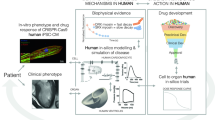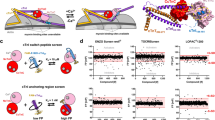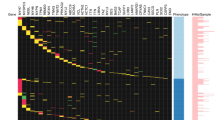Abstract
Mutations of the gene (TNNT2) encoding the thin-filament contractile protein cardiac troponin T are responsible for 15% of all cases of familial hypertrophic cardiomyopathy, the leading cause of sudden death in young athletes1,2. Mutant proteins are thought to act through a dominant-negative mode that impairs function of heart muscle3. TNNT2 mutations can also lead to dilated cardiomyopathy, a leading cause of heart failure4. Despite the importance of cardiac troponin T in human disease, its loss-of-function phenotype has not been described. We show that the zebrafish silent heart (sih) mutation affects the gene tnnt2. We characterize two mutated alleles of sih that severely reduce tnnt2 expression: one affects mRNA splicing, and the other affects gene transcription. Tnnt2, together with α-tropomyosin (Tpma) and cardiac troponins C and I (Tnni3), forms a calcium-sensitive regulatory complex within sarcomeres5. Unexpectedly, in addition to loss of Tnnt2 expression in sih mutant hearts, we observed a significant reduction in Tpma and Tnni3, and consequently, severe sarcomere defects. This interdependence of thin-filament protein expression led us to postulate that some mutations in tnnt2 may trigger misregulation of thin-filament protein expression, resulting in sarcomere loss and myocyte disarray, the life-threatening hallmarks of TNNT2 mutations in mice and humans6,7.
This is a preview of subscription content, access via your institution
Access options
Subscribe to this journal
Receive 12 print issues and online access
$259.00 per year
only $21.58 per issue
Buy this article
- Purchase on SpringerLink
- Instant access to full article PDF
Prices may be subject to local taxes which are calculated during checkout






Similar content being viewed by others
References
Thierfelder, L. et al. α-tropomyosin and cardiac troponin T mutations cause familial hypertrophic cardiomyopathy: a disease of the sarcomere. Cell 77, 701–712 (1994).
Maron, B.J. et al. Sudden death in young competitive athletes. Clinical, demographic, and pathological profiles. JAMA 276, 199–204 (1996).
Seidman, J.G. & Seidman, C. The genetic basis for cardiomyopathy: from mutation identification to mechanistic paradigms. Cell 104, 557–567 (2001).
Kamisago, M. et al. Mutations in sarcomere protein genes as a cause of dilated cardiomyopathy. N. Engl. J. Med. 343, 1688–1696 (2000).
Tobacman, L.S. Thin filament-mediated regulation of cardiac contraction. Annu. Rev. Physiol. 58, 447–481 (1996).
Varnava, A.M. et al. Hypertrophic cardiomyopathy: histopathological features of sudden death in cardiac troponin T disease. Circulation 104, 1380–1384 (2001).
Tardiff, J.C. et al. Cardiac troponin T mutations result in allele-specific phenotypes in a mouse model for hypertrophic cardiomyopathy. J. Clin. Invest. 104, 469–481 (1999).
Chen, J.N. et al. Mutations affecting the cardiovascular system and other internal organs in zebrafish. Development 123, 293–302 (1996).
Stainier, D.Y. et al. Mutations affecting the formation and function of the cardiovascular system in the zebrafish embryo. Development 123, 285–292 (1996).
Burggren, W.W. & Pinder, A.W. Ontogeny of cardiovascular and respiratory physiology in lower vertebrates. Annu. Rev. Physiol. 53, 107–135 (1991).
Fyrberg, E., Fyrberg, C.C., Beall, C. & Saville, D.L. Drosophila melanogaster troponin-T mutations engender three distinct syndromes of myofibrillar abnormalities. J. Mol. Biol. 216, 657–675 (1990).
Nasevicius, A. & Ekker, S.C. Effective targeted gene 'knockdown' in zebrafish. Nature Genet. 26, 216–220 (2000).
Amemiya, C.T., Zhong, T.P., Silverman, G.A., Fishman, M.C. & Zon, L.I. Zebrafish YAC, BAC, and PAC genomic libraries. Methods Cell Biol. 60, 235–258 (1999).
O'Neill, J.P., Rogan, P.K., Cariello, N. & Nicklas, J.A. Mutations that alter RNA splicing of the human HPRT gene: a review of the spectrum. Mutat. Res. 411, 179–214 (1998).
Maquat, L.E. & Carmichael, G.G. Quality control of mRNA function. Cell 104, 173–176 (2001).
Edmondson, D.G. & Olson, E.N. Helix-loop-helix proteins as regulators of muscle-specific transcription. J. Biol. Chem. 268, 755–758 (1993).
Moolman, J.C. et al. Sudden death due to troponin T mutations. J. Am. Coll. Cardiol. 29, 549–555 (1997).
Tardiff, J.C. et al. A truncated cardiac troponin T molecule in transgenic mice suggests multiple cellular mechanisms for familial hypertrophic cardiomyopathy. J. Clin. Invest. 101, 2800–2811 (1998).
Westerfield, M. The Zebrafish Book (Univ. of Oregon Press, Eugene, 1995).
Alexander, J., Stainier, D.Y. & Yelon, D. Screening mosaic F1 females for mutations affecting zebrafish heart induction and patterning. Dev. Genet. 22, 288–299 (1998).
Bader, D., Masaki, T. & Fischman, D.A. Immunochemical analysis of myosin heavy chain during avian myogenesis in vivo and in vitro. J. Cell. Biol. 95, 763–770 (1982).
Lin, J.J., Chou, C.S. & Lin, J.L. Monoclonal antibodies against chicken tropomyosin isoforms: production, characterization, and application. Hybridoma 4, 223–242 (1985).
Malouf, N.N., McMahon, D., Oakeley, A.E. & Anderson, P.A. A cardiac troponin T epitope conserved across phyla. J. Biol. Chem. 267, 9269–9274 (1992).
Yelon, D., Horne, S.A. & Stainier, D.Y. Restricted expression of cardiac myosin genes reveals regulated aspects of heart tube assembly in zebrafish. Dev. Biol. 214, 23–37 (1999).
Ohara, O., Dorit, R.L. & Gilbert, W. One-sided polymerase chain reaction: the amplification of cDNA. Proc. Natl Acad. Sci. USA 86, 5673–5677 (1989).
Acknowledgements
We thank A. Navarro and S. Waldron for their dedicated care of our fish, K. MacDonald for his expertise in generating electron micrographs, and M. Brook and F. Aburto for their assistance with the Quicktime movies. We thank C. Kimmel, F. Stockdale, J. Potter, P. Anderson and R. Breitbart for sharing valuable reagents; W. Tidyman, C. Ordahl and B. Black for helpful discussions about cardiac gene regulation and P. Wolters, M. Zeiger, R. Reijo-Pera and members of the Stainier lab for their comments on this manuscript. A.S. was supported as a March of Dimes fellow of the Pediatric Scientist Development Program and by the American Heart Association Western States Affiliate. This work was supported in part by grants from the National Institutes of Health (to A.S., M.C.F. and D.Y.R.S., and to Charles Kimmel supporting the mutagenesis screen), as well as grants from the Packard Foundation and the American Heart Association (to D.Y.R.S.).
Author information
Authors and Affiliations
Corresponding author
Ethics declarations
Competing interests
The authors declare no competing financial interests.
Supplementary information
Rights and permissions
About this article
Cite this article
Sehnert, A., Huq, A., Weinstein, B. et al. Cardiac troponin T is essential in sarcomere assembly and cardiac contractility. Nat Genet 31, 106–110 (2002). https://doi.org/10.1038/ng875
Received:
Accepted:
Published:
Issue date:
DOI: https://doi.org/10.1038/ng875
This article is cited by
-
Latrophilin-2 mediates fluid shear stress mechanotransduction at endothelial junctions
The EMBO Journal (2024)
-
Glia maturation factor-γ is required for initiation and maintenance of hematopoietic stem and progenitor cells
Stem Cell Research & Therapy (2023)
-
A bioelectrical phase transition patterns the first vertebrate heartbeats
Nature (2023)
-
Multiple pkd and piezo gene family members are required for atrioventricular valve formation
Nature Communications (2023)
-
Transcriptome studies of inherited dilated cardiomyopathies
Mammalian Genome (2023)



